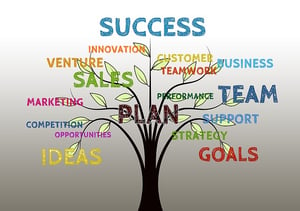Inbound marketing is a new way of marketing to your customers that appeals to them, sometimes it can be hard to find answers and suggestions to common roadblocks. This newer and more appealing form of marketing, is effective because it doesn’t spam customers, it instead aligns and educates them with the products they need or want. It is all about the right place, at the right time, to the right person, everytime. Here at Vital Digital, we have curated steps to help you rebuild and create an effective inbound marketing strategy. You can master the inbound marketing strategy by creating and understanding your company’s purpose, setting business goals, developing your buyers journey in order to bring in and preserve customers, and analyzing your progress.
-
Creating your company’s purpose:
-
Buyer personas:
 If you want your company to grow better, you need a deep understanding of your ideal buyer. This can not be done without first developing your company’s purpose.
If you want your company to grow better, you need a deep understanding of your ideal buyer. This can not be done without first developing your company’s purpose.
What is a buyer persona: In order to develop a buyer persona, we first have to understand what it is and how it is used. A buyer persona is a semi-fictional representation of your ideal buyer, curated using data, interviews, and some educated guesses. It should be used to inform everything your customer facing teams do, sales, marketing, and customer service. This will allow your customer facing teams best serve your customers.
How to Create a buyer persona: In order to create a buyer persona, one team should manage the task, however, it should include the input from many different departments in the workplace. Even the non-customer facing teams might have insightful input. For instance, finance might be able to tell you who is most likely to fulfill their financial promises. Next, you have to define the information that should be included in the buyer persona. In order to do this, look to your company’s purpose, or look at customer’s traits that have high success when using your product. Creating your company’s purpose and buyer personas are an important first step when creating your inbound marketing strategy.
- Setting Business Goals:
Setting business goals allows for accountability, a sense of camaraderie, and a basis for transparency across all teams in the workplace. Without a set goal, each team will place different priorities on assignments and overall productivity will decline. Business goals create alignment, transparency, and productivity.
- Goals that align with your company’s purpose:
In order to create goals that align with your company’s purpose you need to create objectives and key results. Objectives and key results help ensure that the company focuses its efforts on the same important issues in each department. Objectives are significant, concrete, action oriented, and ideally aspirational (answers where do you want to go, conveys your endpoint). Whereas key results are how you bench mark, and how you get to your get to your goal. Key results are specific, time bound, aggressive, realistic, measurable, and verifiable. These can be numeric, improving sales goals by x percent, or binary, either you did or did not reach your goal, usually shown as a 1 or a 2. Objectives and key results are a shared tool each department uses in order to stay on track to reach the set business goals.
- Three Horizons Framework:
The three horizons framework is a way to conceptualize what your business wants to complete in the short term, midterm, and long term. In the short term, or horizon one, you should be focused on sustaining business, optimizing efficiency, and doubling down on assets. Horizon one should use about 70% of your time and resources. Midterm goals, or horizon two, helps bridge short term and long term goals, it helps with the failings of the short term and anticipates needs in the long term. About 20% of time and resources should be spent in horizon two. Finally, the long term, horizon three, is where you focus on innovating, creating new business models, and predicting where your industry is headed. Horizon three should only use about 10% of your time and resources. By using the three horizons framework, it will help your company be able to set goals in order to sustain the company and innovate.
- Developing your Buyer’s Journey:
The buyer’s journey is the active research process someone goes through leading up to a purchase. It's a fundamental part of an inbound strategy, because it’s a framework you can use to understand your buyer’s needs, and provide the information they need to reach their goals. The buyer's journey can be broken up into three parts:
- Awareness: When your prospect is experiencing and expressing symptoms of a problem or opportunity.
- Consideration: Defined and given name to problem or opportunity.
- Decision: Decided on their solution strategy, method, or approach.

- How to Create your Buyer’s journey:
Creating the buyer's journey for your business, needs to be developed in each stage around your business’s specific needs and persona’s intent. In each stage you need to know your buyer’s needs so you can provide the most useful information in each stage of their journey.
- Awareness stage: In this stage, you need to provide research, so that they can understand, frame, and name their problem. You want to establish yourself and your brand as reliable so that the buyer will be more inclined to continue their journey with you.
- Consideration stage: Engagement is key in this stage, your buyer is committed to researching and understanding all available approaches or methods to solving their defined problem. By engaging with your customers in this stage you can develop lasting relationships that will be useful in the final stage.
- Decision stage: Reassure your buyer that they made the correct decision by choosing you in this stage. This stage is a great one to utilize your customer service team. The most important content in this stage is questions about your product or how to use your product. By curating content to your buyer in each stage, it will help you establish your brand as trustworthy, allow you to build relationships, and hopefully, let satisfied customers bring in more.
- Bring in Customers by combining flywheel and funnel:
A flywheel is a machine that stores rotational energy. When you add energy to a flywheel, it starts to spin. If you add more energy to it, it spins faster. You should think of your business, as a whole, as a flywheel. This doesn’t mean that you completely want to stop using funnels, they can be useful in individual departments, but flywheels encourage satisfying employees instead of relying on marketing to bring in new business. A funnel only remains constant if you put in more, while a flywheel continues spinning and spins faster when energy is added. The energy, being good customer experiences. Even if there is one bad experience, it won’t stop the flywheel. Everything you do, should be done with the goal of creating customers who will add positive energy to the flywheel and accelerate your company’s growth.
- Preserving Customers by Attracting, Engaging, and Delighting:
There are three stages to create and maintain relationships. Each stage needs to be completed with all three customer facing teams. It is not the job of only one of the teams to attract, engage, or delight. In each stage all three teams can and should attract, engage, and delight.
- Attract: By creating and providing relevant and helpful content you will be able to create trustworthy relationships with your customers. Provide them with contextual content: content that relates to the question being asked, outcome being sought, or goal.
- Engage: This stage begins the moment a person takes action, you will collect information about the individual you’re working with. In this stage you need to build trust, find what motivates your customer, and have the expertise to help them solve their problems.
- Delight: In order to delight, you need to provide an outstanding experience by having a system to help delight those prospects or customers so that they become promoters. Make it easy for your customers to find the information they are looking for. If each team attracts, engages, and delights, you will have stronger and longer lasting relationships with your customers.
- Analyze Progress:
- Standardized for consistency: If a customer asks anyone in your company a question, the answer should be the same every time. This is essential for building trust. If it is different, then the customer might get confused and won’t be satisfied.
- Contextualize for relevance: By contextualizing only for relevance, it prevents repetitive conversations, confusion, and time loss. Providing information to help with the customers needs and problems will help with productivity and customer satisfaction. Everyone wants their problem solved quickly.
- Optimize for clarity: Analyzing different marketing and communication channels will help you be able to reach your customer faster. If there are too many communication channels, your customer won’t know which one works the best or fastest.
- Personalize for impact: Use customer files to be able to adapt to each conversation, making your customer feel heard and important.
- Empathize for perspective: Inbound is a personalized form of marketing, by empathizing it lets your customers know that you care and forms deeper relationships.

Why Inbound:
Inbound marketing is personal and relies on connections. Although change is hard, your customers will appreciate this personalized, human, approach to marketing. No one wants to be spammed with computer generated emails. The inbound strategy not only satisfies your customers, but will also help your customer facing teams, by increasing workplace satisfaction and creates understanding that people are human and not a problem to be solved.
You can become Inbound certified through HubSpot today! If these steps seem overwhelming and you don’t have enough time to get certified, contact Vital Digital for your Inbound digital marketing needs.
Download our full collection of inbound marketing examples here.


